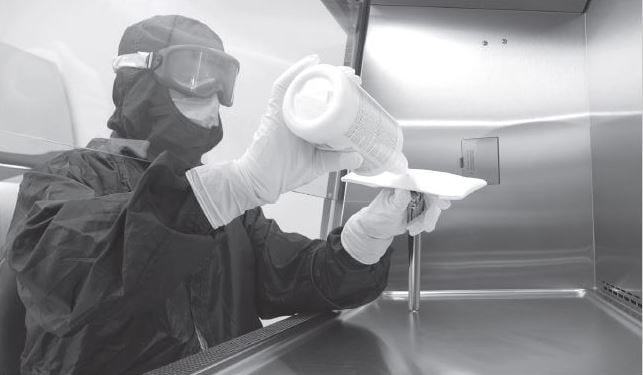EU GMP Annex 1 - Impact on Cleaning and Disinfection
Cleaning and microbial contamination control are critical focus areas in pharmaceutical and medical device industries. Robust cleaning and disinfection programs are needed to meet the required cleanroom microbial grades, to prevent cross contamination and subsequent microbial contamination of products.
EU GMP Annex 1
Recently updated EU GMP Annex 1, which specifies guidance for the manufacture of sterile medicinal products was published in August 2022, with an implementation date of 25th August 2023, with the exception of the sterilization of manual lyopholizers.
The previous 16- page document has been replaced with a 59 page document, each topic has been significantly expanded, new topics have been included and the concept of risk management is embedded throughout the document. One of the main documentary requirements of the new draft is the requirement for a holistic contamination control strategy (CCS).
Cleaning and Disinfection
The references to cleaning and disinfection within the annex have been expanded. The word disinfection has been used to replace sanitation as the title of the section. The terminology of “cleaning” has been replaced with “cleaning and disinfection”. The text notes that “For disinfection to be effective, prior cleaning to remove surface contamination should be performed." This clarifies current best practice that cleaning and disinfection are two distinct activities trying to achieve different things.
Cleaning is defined as "A process for removing contamination e.g. product residues or disinfectant residues.” Disinfection is subsequently defined as “The process by which the reduction of the number of microorganisms is achieved by the irreversible action of a product on their structure or metabolism, to a level deemed to be appropriate for a defined purpose.”
Residues
Many common and well used disinfectants, for example amines, amphoterics and quaternary ammonium compounds leave significant residues on a surface, which can subsequently have a detrimental effect on the effectiveness of the disinfectant used. This is acknowledged in the new annex, "Cleaning programs should effectively remove disinfectant residues." Pharmaceutical companies have been cited for the presence of residues and the presence of visible residues has often been seen in the past as an indication that a cleaning and disinfection process is not fully in control.
There are currently no approved or published methods for assessing the amount of residue on non-product contact surfaces and most facilities conduct a visual test for residues on non-product contact surfaces. Alcohols and hydrogen peroxide are the only two disinfectants that truely leave no residue. All other disinfectants leave a residue, some worse than others, some easier to remove than others. Some disinfectants claim that they are “no” residue or “low” residue but there is no accepted definition of low residue. Even if a disinfectant is low residue, if it is difficult to remove, is that actually a relevant measure. It must also be remembered that all detergents leave a residue.
Extrusion-based bioprinters use pressure to drive the sample though a nozzle and create a pre-defined shape. Because the pressure can easily be adjusted for different viscosity sample types, extrusion-based bioprinting is often favored by researchers for its flexibility. Bioprinters based on the use of electric fields offer the highest precision. However, this comes at a price and methods must be rigorously optimized to avoid causing cellular damage. Disinfectants either need to be: wiped to dry after the contact time, have an immediate residue removal stage added with water or alcohol, or plan in a routine clean with a detergent to remove residues at a validated point.
Rotation
Regulatory guidelines have not been aligned on the subjection of disinfectant rotation and the number of disinfectants which need to be used. EU GMP Annex 1 previously stated that “more than one type of disinfecting agent should be employed” and this is repeated in the new revision. Additionally, it states why, to ensure that where they have different modes of action, their combined usage is effective against bacteria and fungi. In line with other regulatory guidance it also clearly states that disinfection should include the periodic use of a sporicide.
This leads to many questions from end users. How many disinfectants do I need? Does this say I must rotate disinfectants with different modes of action, is this because of resistance, what does periodic use mean ? This all becomes easier to answer when we remember that risk management is embedded in with the philosophy of the annex. The number & frequency of disinfectants to use, will be decided upon reviewing the trends of the environmental programme and periodic auditing of the cleaning and disinfection process. Our discussions with the MHRA confirmed that if EM results/trends are under control, there would be no stipulated need to have achieved this using a rotational disinfectant programme or disinfectants with different modes of action.
Many facilities will routinely use a broad-spectrum disinfectant in rotation with a sporicide kept for intermittent or action point use. This is mainly due to the corrosive or aggressive nature of many sporicidal biocides rather than any concern over resistance. The more recent availability of highly effective cleanroom sporicides with no classified hazard may change this approach.
A typical biodecontamination programme would consist of daily disinfection with a broad spectrum disinfectant or alcohol, periodic use of a sporicide based on environmental monitoring. Every day after cleaning and disinfection (unless alcohol or hydrogen peroxide) rinse with WFI or alcohol or wipe to dry. After spills, maintenance or periodically to remove built up residues, a clean should be carried out with a neutral, low foaming, detergent. Not forgetting that Annex 1 also continue to state that “Disinfectants and detergents used in Grades A and B should be sterile prior to use. Disinfectants used in Grade C and D may also be required to be sterile where determined in the CCS.”
For any help or guidance on a biodecontamination programme, request a Contamination Control Assessment via your Fisher Rep.





